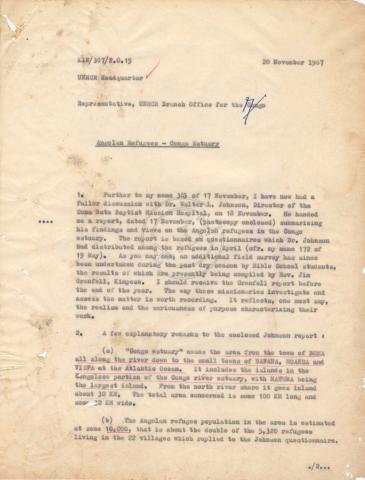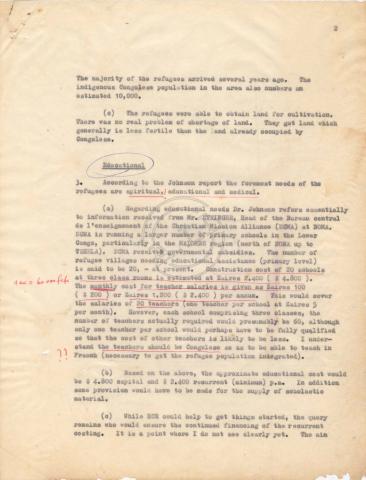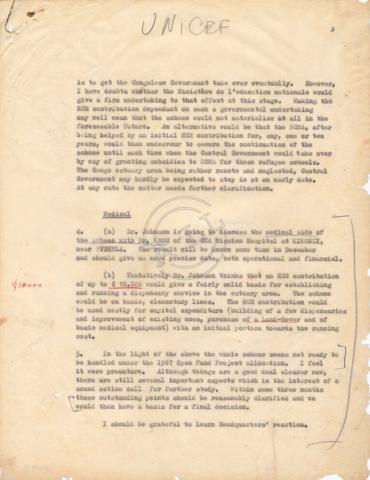Cota
0098.000.010
Tipologia
Texto de Análise
Impressão
Dactilografado (2ª via)
Suporte
Papel Comum
Autor
UNHCR
Data
Idioma
Conservação
Razoável
Fundo
Imagens
3
KIN/387/2.0.15 20 November 1967
UNHCR Headquarter
Representative, UNHCR Branch Office for the Congo
Angolan Refugees - Congo Estuary
1. Further to my memo 383 of 17 November, I have now had a fuller discussion with Dr. Walter L. Johnson, Director of the Sona Bata Baptista Mission Hospital, on 18 November. He handed me a report, dated 17 November, (photocopy enclosed) summarizing his findings and views on the Angolan refugees in the Congo estuary. The report is based on questionnaires which Dr. Johnson had distributed among the refugees in April (ofr. my memo 172 of 19 May). As you may see, an additional field survey has since been undertaken during the past dry season by Bible School students, the results of which are presently being complied by Rev. Jim Grenfell, Kimpese. I should receive the Grenfell report before the end of the year. The way these missionaries investigate and assess the matter in worth recording. It reflects, one must say, the realism and the seriousness of purpose characterizing their work.
2. A few explanatory remarks to the enclosed Johnson report:
(a) “Congo estuary means the area from the town of BOMA all along the river down to the small towns of BANANA, MOANDA and VISTA at the Atlantic Ocean. It includes the islands in the Congolese portion of the Congo River estuary, with NATEBA being the largest island. From the north river share it goes island about 30km. The total area concerned is some 100km long and some 30km wide.
(b) The Angolan refugee population in the area is estimated at some 10,000, that is about the double of the 5,320 refugees living in the 22 villages which replied to the Johnson questionnaire.
The majority of the refugees arrived several years ago. The indigenous Congolese population in the area also numbers an estimated 10,000.
(c) The refugees were able to obtain land for cultivation. There was no real problem of shortage of land. They got land which generally is less fertile than the land already occupied by Congolese.
Educational
3. According to the Johnson report the foremost needs of the refugees are spiritual, educational and medical.
(a) Regarding educational needs Dr. Johnson refers essentially to information received from Mr. STRINGER, Head of the Bureau central de l’enseignement of the Christian Mission Alliance (ECMA) at BOMA. ECMA is running a larger number of primary schools in the Lower Congo, particularly in the MAIOMBE region (north of BOMA up to TSHELA). ECMA receives governamental subsidies. The number of refugee villages needing educational assistance (primary level) os said to be 20, - st present. Construction cost of 20 schools at three class rooms is estimated at Zaires 2.400 ($4.800). The monthly cost for teacher salaries is given as Zaires 100 ($200) or Zaires 1.200 ($2.400) per annum. This would cover the salaries of 20 teachers actually required would presumably be 60, although only one teacher per school would perhaps have to be fully qualified so that the cost of other teachers is likely to be less. I understand the teachers should be Congolese so as to be able to teach in french (necessary to get the refugee population integrated).
(b) Based on the above, the approximate educational cost would be $4.800 capital and $2.400 recurrent (minimum) p.s. In addition some provision would have to be made for the supply of scholastic material.
(c) While HCR could help to get things started, the query remains who would ensure the continued financing of the recurrent costing. It is a point where I do not see clearly yet. The aim is to get the Congolese Government take over eventually. However, I have doubts whether the Ministère de l’education nationale would give a firm undertaking to that effort at this stage. Making the HCR contribution dependant on such a governmental undertaking may well mean that the scheme would not materialize at all in the foreseeable future. An alternative would be that the BOMA, after being helped by an initial HCR contribution for, say, one or two years, would then endeavour to secure the continuation of the scheme until such time when the Central Government would take over by way of granting subsidies to ECMA for these refugee schools. The Congo estuary area being rather remote and neglected, Central Government may hardly be expected to stop in at an early date. At any rate the matter need further clarification.
Medical
4. (a) Dr. Johnson is going o discuss the medical side of the scheme with Dr. KROH of the CMA Mission Hospital at KIKONCI, near ITSHELA. The result will be known some time in December and should give us more precise date, both operational and financial.
(b) Tentatively Dr. Johnson thinks that an HCR contribution of up to $10,00 would give a fairly solid basis for establishing and running a dispensary service in the estuary area. The scheme would be on basic, elementary lines. The HCR contribution would be used mostly for capital expenditure (building of a few dispensaries and improvement of existing ones, purchase of a land-Rover and of basic medical equipment) with an initial portion towards the running cost.
5. In the light of the above the whole scheme seems not ready to be handled under the 1967 Open Fund Project allocation. I feel is where premature. Although things are a good deal clearer now, there are still several important aspects which in the interest of a sound action call for a further study. Within some three months these outstanding points should be reasonably clarified and we would then have a basis for a final decision.
I should be grateful to learn Headquarters’ reaction.
Documento do UNHCR sobre refugiados angolanos «Angolan refugees – Congo Estuary»
A publicação, total ou parcial, deste documento exige prévia autorização da entidade detentora.



